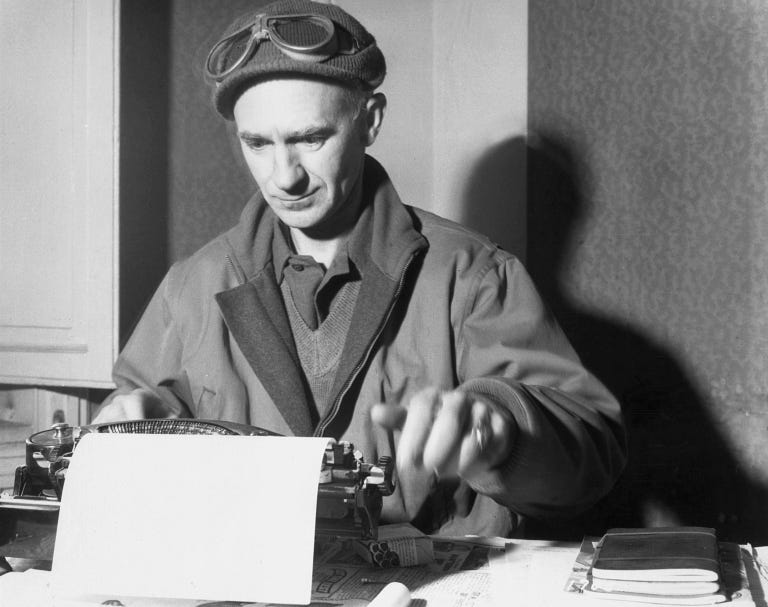Welcome to Ridgway’s Notebook, your home for airborne PME. We offer penetrating essays on military history. Through the World War II experiences of General Matthew Ridgway and the 82nd Airborne Division, we illustrate some of the similarities between the questions asked by officers of the 82nd yesterday and today—and dissect how they came to be.
There are five books I can’t live without. My wooden desk has a special cubby for them, and at least one is always to be found bouncing around the bottom of my messenger bag; it provides relief from stouter tomes. They are close at hand because I find inspiration in them. They fertilize my mind and patriotism, and inspire my prose in gridlock. One book, however, is stowed in a wooden box, secure as a jewel.
Brave Men by Ernie Pyle is a wartime book. An official seal guarantees its bona fides, and assures its printing did not drain paper resources for war. It’s now approaching old age, and like any living thing its binding isn’t as strong as it “once was.” Hence it living in a box, and not my bag.
I was introduced to Pyle because we shared an interest in the story of the American soldier. Soldier, not soldierly, is used as a matter of high distinction. Pyle was interested in the soldier. His dispatches employed the same precision Jesus used to call his disciples — he called them by name. Instant stardom in one’s hometown was to be mentioned in a Pyle dispatch. It’s how I became aquatinted with Brave Men — singled out was one Captain Francis Sheehan, 22 North Gray Street, Indianapolis.
I have read on the current recruiting crisis facing the military. James Mattis recently linked it to the history crisis in schools. He lamented that history is not in a position to “breed affection” for the country. Its concern with critical theories could not place it in more stunning contrast to the preface of an American history textbook dated 1900.
This work is offered to American youth in the confident belief that as they study the wonderful history of their native land they will learn to prize their birthright more highly, and treasure it more carefully. Their patriotism must be kindled when they come to see how slowly, yet how gloriously, this tree of liberty has grown, what storms have wrenched its boughs, what sweat of toil and blood has moistened its roots, what eager eyes have watched every out-springing bud, what brave hearts have defended it, loving it even unto death. A heritage thus sanctified by the heroism and devotion of the fathers can not but elicit the choicest care and tenderest love of the sons.1
Ernie Pyle’s narrative power comes from his treatment of “brave hearts” — un-rankly men. The title of his best known book — Brave Men — is sheer. It’s what prompted me to snatch it faster than lightning when my eyes fell upon the spine at Barnes & Noble. I bought this fresh printing although I have a genuine article, seal and all. This one can live in the cubby, and be bent, thrashed, and soiled in repeated engagements.
And during the war that is how Pyle described the dogface in the foxholes, and nurtured America’s affection for him. The storms are told in his description of drawn eyes and stubble-studded faces; the toil in Pyle’s pinpoint diagnosis of the manner of dirt on Francis Sheehan’s face. As Pyle lays words like bricks, one building upon another, affection for America is built. Thanks to Penguin Classics, Ernie Pyle can nurture this affection again.
Sheehan was forever known in his community for — among other things — his brief entrance into Brave Men’s pages, it was even noted in his obituary. May he forever be so known.
Reenforced Winter 2: All Americans in the Battle of the Bulge
I have been like a hunter armed with words, attempting to whittle them into a snare to catch my thoughts coming down the trail. The themes I need to convey in “Reenforced Winter 2” are not coming in the relief I need them. Hopefully I will have sharpened my sticks and tied my wire well to wrap up my ideas by next week. If you arrived this week just for the follow-up to “Reenforced Winter,” I hope you’ll be back next week. It’ll be worth it.
📚READ OF THE WEEK📚
Steele, J.D. A brief history of the United States. American Book Company (1900)







Temple Railroad and Heritage Museum - a not bad example of the potential of a community based museum.
Ernie Pyle's work as a war correspondent produced two amazing things - his body of work reflecting the experiences of the average soldier and the devotion that his efforts to tell their story evoked among GIs, Marines, Air Corps/Air Force personnel, and sailors. The film GI Joe told a part of his story with Burgess Meredith portraying Ernie. Robert Mitchum portrayed a US Army officer, Lieutenant later Captain Walker - based upon the story of Captain Waskow told in a series of dispatches filed by Pyle. and ending with the Captain's death. It would turn out that a museum in Temple, Texas where my daughter would work had Captain Waskow's uniform and some personal effects on exhibit. I was surprised that she didn't know the story and it wasn't mentioned in the exhibit.